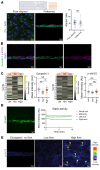Mechanosensitive membrane domains regulate calcium entry in arterial endothelial cells to protect against inflammation
- PMID: 38771648
- PMCID: PMC11213468
- DOI: 10.1172/JCI175057
Mechanosensitive membrane domains regulate calcium entry in arterial endothelial cells to protect against inflammation
Abstract
Endothelial cells (ECs) in the descending aorta are exposed to high laminar shear stress, and this supports an antiinflammatory phenotype. High laminar shear stress also induces flow-aligned cell elongation and front-rear polarity, but whether these are required for the antiinflammatory phenotype is unclear. Here, we showed that caveolin-1-rich microdomains polarize to the downstream end of ECs that are exposed to continuous high laminar flow. These microdomains were characterized by high membrane rigidity, filamentous actin (F-actin), and raft-associated lipids. Transient receptor potential vanilloid (TRPV4) ion channels were ubiquitously expressed on the plasma membrane but mediated localized Ca2+ entry only at these microdomains where they physically interacted with clustered caveolin-1. These focal Ca2+ bursts activated endothelial nitric oxide synthase within the confines of these domains. Importantly, we found that signaling at these domains required both cell body elongation and sustained flow. Finally, TRPV4 signaling at these domains was necessary and sufficient to suppress inflammatory gene expression and exogenous activation of TRPV4 channels ameliorated the inflammatory response to stimuli both in vitro and in vivo. Our work revealed a polarized mechanosensitive signaling hub in arterial ECs that dampened inflammatory gene expression and promoted cell resilience.
Keywords: Calcium signaling; Cell biology; Endothelial cells; Vascular biology.
Conflict of interest statement
Figures










References
MeSH terms
Substances
Grants and funding
LinkOut - more resources
Full Text Sources
Molecular Biology Databases
Miscellaneous

